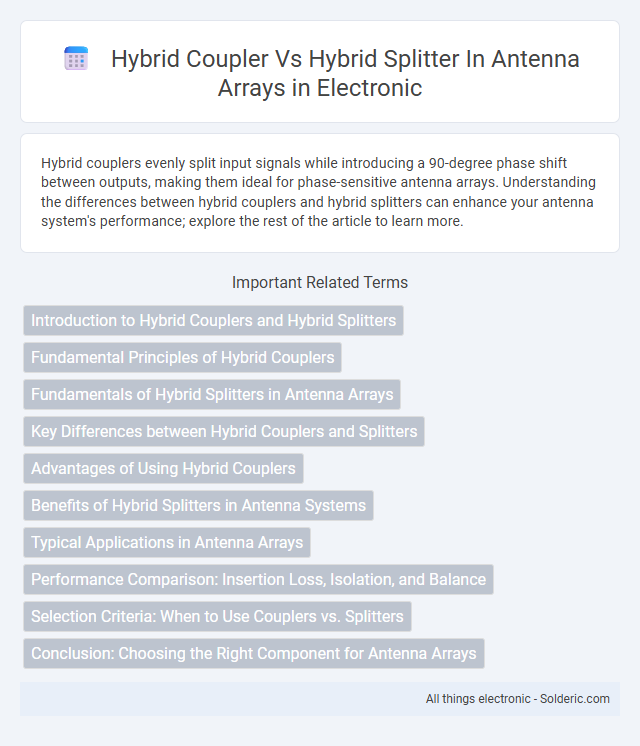Hybrid couplers evenly split input signals while introducing a 90-degree phase shift between outputs, making them ideal for phase-sensitive antenna arrays. Understanding the differences between hybrid couplers and hybrid splitters can enhance your antenna system's performance; explore the rest of the article to learn more.
Comparison Table
| Feature | Hybrid Coupler | Hybrid Splitter |
|---|---|---|
| Function | Combines or splits signals with fixed phase shifts | Divides input signal into equal output signals without phase shift |
| Phase Difference | Provides 90deg or 180deg phase difference between outputs | Outputs are in phase (0deg phase difference) |
| Insertion Loss | Low insertion loss, typically 3 dB per output | Minimal insertion loss, ideally 3 dB per output |
| Isolation | High isolation between ports | Lower isolation compared to couplers |
| Typical Use | Phase control in antenna arrays, balanced mixing, signal routing | Power division in antenna feeding networks |
| Port Configuration | Four ports: two input/output, two isolated | Two or more output ports from one input |
| Applications | Beamforming, phased array antennas, mixers | Signal distribution, power splitting in arrays |
Introduction to Hybrid Couplers and Hybrid Splitters
Hybrid couplers and hybrid splitters are essential components in antenna arrays used to efficiently manage signal distribution and combining. A hybrid coupler typically splits an input signal into two output signals with equal amplitude but different phase shifts, enabling signal phase manipulation for beamforming and signal isolation. Hybrid splitters, on the other hand, divide a single input signal into multiple output signals with equal power, ensuring balanced signal distribution without affecting phase relationships, crucial for maintaining antenna array performance.
Fundamental Principles of Hybrid Couplers
Hybrid couplers operate on the principle of splitting an input signal into two outputs with equal amplitude but a defined phase difference, typically 90deg or 180deg, essential for balanced antenna array feeding and beamforming. Unlike hybrid splitters that simply divide power without introducing a specific phase shift, hybrid couplers utilize quadrature hybrids or branch-line networks to achieve precise phase control, minimizing signal reflection and insertion loss. This phase manipulation enables coherent signal combining and improved array performance, critical in advanced antenna systems requiring directional control and impedance matching.
Fundamentals of Hybrid Splitters in Antenna Arrays
Hybrid splitters in antenna arrays are fundamental components that divide an input signal into multiple output signals with equal amplitude and specific phase differences, crucial for beamforming and signal distribution. Typically implemented as 3-dB couplers, they ensure minimal insertion loss and high isolation, enabling efficient power division without signal distortion. Their precise phase control and amplitude balance optimize array performance, enhancing antenna gain and reducing interference.
Key Differences between Hybrid Couplers and Splitters
Hybrid couplers and hybrid splitters serve distinct roles in antenna arrays, with couplers primarily enabling signal combination or separation with phase shifting, while splitters divide input power equally without phase alteration. Hybrid couplers offer precise control over signal phase and amplitude, crucial for beamforming and diversity applications, whereas splitters focus on simple power division to feed multiple antenna elements uniformly. Understanding these key differences ensures Your system design achieves optimal signal distribution and performance.
Advantages of Using Hybrid Couplers
Hybrid couplers in antenna arrays offer superior phase and amplitude balance compared to hybrid splitters, ensuring more accurate signal distribution and enhanced beamforming capabilities. These devices provide inherent isolation between output ports, reducing signal interference and improving overall antenna array performance. Their precise phase shift characteristics enable better control over signal directionality, which is crucial for advanced MIMO and phased array systems.
Benefits of Hybrid Splitters in Antenna Systems
Hybrid splitters in antenna systems offer superior power distribution with minimal signal loss, enhancing overall system efficiency. They provide improved isolation between ports, reducing interference and maintaining signal integrity in complex antenna arrays. Their compact design and broadband performance make them ideal for modern phased array and MIMO antenna applications.
Typical Applications in Antenna Arrays
Hybrid couplers are typically used in antenna arrays for signal combining and phase shifting, enabling beamforming and diversity gain improvements. Hybrid splitters distribute input power evenly across multiple antenna elements, ensuring uniform signal feeding for consistent radiation patterns. Your antenna system benefits from hybrid couplers when precise phase control is needed, while hybrid splitters are ideal for straightforward power division.
Performance Comparison: Insertion Loss, Isolation, and Balance
Hybrid couplers exhibit lower insertion loss and superior isolation compared to hybrid splitters, making them ideal for high-performance antenna arrays requiring minimal signal degradation and crosstalk. The inherent phase and amplitude balance within hybrid couplers ensures more accurate signal distribution, enhancing array efficiency and beamforming capabilities. Hybrid splitters typically show higher insertion loss and less isolation, resulting in reduced overall system performance and increased susceptibility to interference.
Selection Criteria: When to Use Couplers vs. Splitters
Hybrid couplers provide precise phase and amplitude control, making them ideal for beamforming and signal combining in advanced antenna arrays, while hybrid splitters are better suited for simple power division where phase control is less critical. Your choice depends on the need for phase matching and isolation; couplers are selected when signal coherence and minimal interference are required, whereas splitters are preferred for straightforward signal distribution with minimal complexity. Performance factors like insertion loss, isolation, and frequency bandwidth play crucial roles in determining whether a hybrid coupler or splitter optimally meets your antenna array design requirements.
Conclusion: Choosing the Right Component for Antenna Arrays
Hybrid couplers and hybrid splitters serve distinct purposes in antenna arrays, with couplers primarily enabling signal phase shifting and combining, while splitters focus on dividing input signals evenly. Your choice depends on the array's design requirements, such as whether phase control or simple power division is critical for optimal performance. Selecting the right component ensures improved signal integrity, enhanced beamforming capabilities, and overall system efficiency.
hybrid coupler vs hybrid splitter in antenna arrays Infographic

 solderic.com
solderic.com